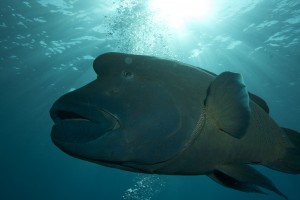The Maori wrasse is one of the most photographed fish on the Great Barrier Reef as these loveable creatures seek out divers, often nudging them for attention. Take that photo with your new friend, but don’t be tempted to hug “Wally” as you will wipe off the protective layer of mucous which keeps him immune from infection.
Many dive sites have a resident Maori wrasse and Passions of Paradise is often greeted by Wally who hangs around to see who will be joining him for a swim.
Wally may indeed be Wilma, especially if it is a smaller Maori wrasse. These fish can change sex with some members of the population becoming male at about 9 years of age.
They are one of the Great Barrier Reef’s largest species of fish with males reaching 2m in length and females rarely exceeding 1m. These solitary creatures live for 25-30 years.
Large, thick lips and a hump on their head are the main features of the Maori wrasse which comes in a dazzling array of colours. The larger males can be an electric blue, some have a hint of purple while others are more green. The females and younger fish are shades of red and orange.
Maori wrasse are opportunistic predators, preying primarily on crustaceans, molluscs, fish, and echinoderms which includes the crown-of-thorns starfish.
Also known as the humphead wrasse, Napoleon wrasse and Napoleon fish, the scientific name for Wally is Cheilinus undulatus.
They are listed as ‘Vulnerable’ by the International Union for the Conservation of Nature (IUCN).
Article by Russell Hosp
Environmental & Sustainability Coordinator
Passions of Paradise

